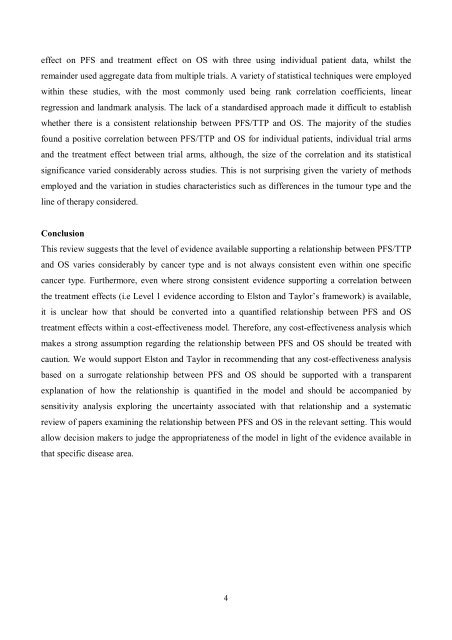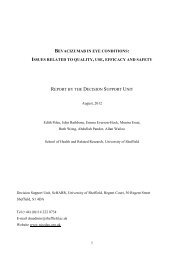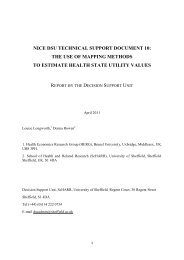A review of studies examining the relationship between progression ...
A review of studies examining the relationship between progression ...
A review of studies examining the relationship between progression ...
You also want an ePaper? Increase the reach of your titles
YUMPU automatically turns print PDFs into web optimized ePapers that Google loves.
effect on PFS and treatment effect on OS with three using individual patient data, whilst <strong>the</strong>remainder used aggregate data from multiple trials. A variety <strong>of</strong> statistical techniques were employedwithin <strong>the</strong>se <strong>studies</strong>, with <strong>the</strong> most commonly used being rank correlation coefficients, linearregression and landmark analysis. The lack <strong>of</strong> a standardised approach made it difficult to establishwhe<strong>the</strong>r <strong>the</strong>re is a consistent <strong>relationship</strong> <strong>between</strong> PFS/TTP and OS. The majority <strong>of</strong> <strong>the</strong> <strong>studies</strong>found a positive correlation <strong>between</strong> PFS/TTP and OS for individual patients, individual trial armsand <strong>the</strong> treatment effect <strong>between</strong> trial arms, although, <strong>the</strong> size <strong>of</strong> <strong>the</strong> correlation and its statisticalsignificance varied considerably across <strong>studies</strong>. This is not surprising given <strong>the</strong> variety <strong>of</strong> methodsemployed and <strong>the</strong> variation in <strong>studies</strong> characteristics such as differences in <strong>the</strong> tumour type and <strong>the</strong>line <strong>of</strong> <strong>the</strong>rapy considered.ConclusionThis <strong>review</strong> suggests that <strong>the</strong> level <strong>of</strong> evidence available supporting a <strong>relationship</strong> <strong>between</strong> PFS/TTPand OS varies considerably by cancer type and is not always consistent even within one specificcancer type. Fur<strong>the</strong>rmore, even where strong consistent evidence supporting a correlation <strong>between</strong><strong>the</strong> treatment effects (i.e Level 1 evidence according to Elston and Taylor’s framework) is available,it is unclear how that should be converted into a quantified <strong>relationship</strong> <strong>between</strong> PFS and OStreatment effects within a cost-effectiveness model. Therefore, any cost-effectiveness analysis whichmakes a strong assumption regarding <strong>the</strong> <strong>relationship</strong> <strong>between</strong> PFS and OS should be treated withcaution. We would support Elston and Taylor in recommending that any cost-effectiveness analysisbased on a surrogate <strong>relationship</strong> <strong>between</strong> PFS and OS should be supported with a transparentexplanation <strong>of</strong> how <strong>the</strong> <strong>relationship</strong> is quantified in <strong>the</strong> model and should be accompanied bysensitivity analysis exploring <strong>the</strong> uncertainty associated with that <strong>relationship</strong> and a systematic<strong>review</strong> <strong>of</strong> papers <strong>examining</strong> <strong>the</strong> <strong>relationship</strong> <strong>between</strong> PFS and OS in <strong>the</strong> relevant setting. This wouldallow decision makers to judge <strong>the</strong> appropriateness <strong>of</strong> <strong>the</strong> model in light <strong>of</strong> <strong>the</strong> evidence available inthat specific disease area.4





